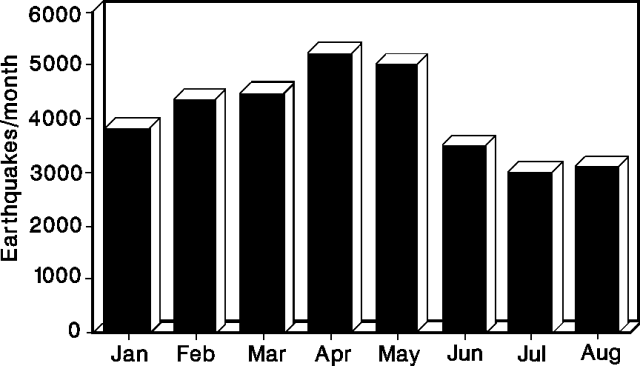Report on Poas (Costa Rica) — August 1991
Bulletin of the Global Volcanism Network, vol. 16, no. 8 (August 1991)
Managing Editor: Lindsay McClelland.
Poas (Costa Rica) Crater lake rises, covering fumaroles; low-frequency seismicity
Please cite this report as:
Global Volcanism Program, 1991. Report on Poas (Costa Rica) (McClelland, L., ed.). Bulletin of the Global Volcanism Network, 16:8. Smithsonian Institution. https://doi.org/10.5479/si.GVP.BGVN199108-345040
Poas
Costa Rica
10.2°N, 84.233°W; summit elev. 2697 m
All times are local (unless otherwise noted)
In August, the crater lake grew to cover all crater fumaroles, while fumarolic activity continued at levels considered "normal" for the volcano. The yearly total of recorded microearthquakes (almost all of low frequency) exceeded 32,500 by the end of the month (figure 40), a decrease from 1990.
Geological Summary. The broad vegetated edifice of Poás, one of the most active volcanoes of Costa Rica, contains three craters along a N-S line. The frequently visited multi-hued summit crater lakes of the basaltic-to-dacitic volcano are easily accessible by vehicle from the nearby capital city of San José. A N-S-trending fissure cutting the complex stratovolcano extends to the lower N flank, where it has produced the Congo stratovolcano and several lake-filled maars. The southernmost of the two summit crater lakes, Botos, last erupted about 7,500 years ago. The more prominent geothermally heated northern lake, Laguna Caliente, is one of the world's most acidic natural lakes, with a pH of near zero. It has been the site of frequent phreatic and phreatomagmatic eruptions since an eruption was reported in 1828. Eruptions often include geyser-like ejections of crater-lake water.
Information Contacts: R. Barquero and G. Soto, ICE; M. Fernández, H. Flores, and S. Paniagua, UCR.


